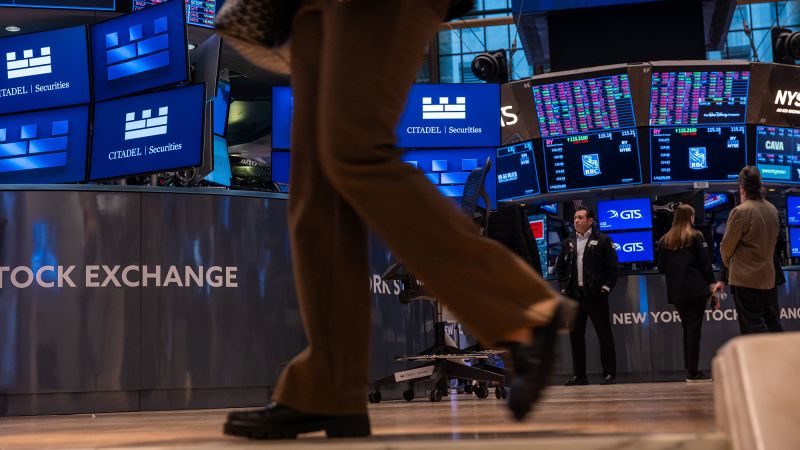The current state of the American financial markets is a complex tapestry of extremes, characterized by stark declines interspersed with brief recoveries. As reported on a recent Tuesday, stocks have experienced a modest rebound following a notably bleak day on Wall Street; however, this one day of positivity hardly mitigates the substantial concerns simmering beneath the surface. Investors have voiced strong reservations regarding the ongoing trade war initiated by President Donald Trump, describing the United States as an increasingly perilous place for investment.
The apprehension among investors is palpable, evident through their trading behaviors and the noticeable trends in market performance. To highlight the gravity of the situation, analysts are drawing alarming parallels to the Great Depression, a time characterized by relentless economic downturns. The Dow Jones Industrial Average, a prominent stock index that has been a fixture in the American financial landscape for 129 years, has seen a staggering decline of 9.1% in the first three weeks of April. This performance marks the worst showing for the Dow in any April since 1932, with 1931 not far behind in a similarly troubling context.
The broader S&P 500 index showcases a grim picture as well, having suffered a remarkable decline of 14% during the course of Trump’s first term. This statistic stands out as the worst start for a U.S. president since 1928, a dubious record underscored by data from Bespoke Investments. In the wake of any slight recovery – with major indexes rising over 2% in recent trading sessions – it remains abundantly clear that Trump has a considerable distance to travel if he hopes to evade the historical ramifications of such a poor start.
In tandem with the declines in stock indexes, the strength of the U.S. dollar has also diminished. During Trump’s current term, the dollar has depreciated by 5.5%, the largest recorded drop since the collection of data began under former President Gerald Ford in 1974. The dollar recently hit a three-year low, prompting traders to reassess their expectations for stability in U.S. financial assets. Traditionally, when turmoil mounts in the markets, investors have gravitated toward the safety of U.S. Treasury bonds. This time, however, yields have surged sharply as prices have dropped, defying historical norms of investment behavior during crisis periods.
The 10-year U.S. Treasury yield recently rose to 4.4%, a notable increase from its sub-4% position just around a month prior. Such rapid fluctuations in bond markets are historically unusual, indicating a significant shift in investor confidence. As these financial upheavals unfold domestically, a concerning trend has emerged wherein capital is being redirected towards international investments. The MSCI All World index, excluding the United States, rose by 2.9% during Trump’s new term, matching performance levels seen during former President Biden’s term and slightly trailing behind those during Trump’s first term.
The energy sector, too, finds itself at the mercy of these overarching trends, as fears of a global economic recession lead to dramatic sell-offs of oil, yielding the worst start for U.S. crude oil under any presidential administration since Bill Clinton’s tenure. The price of oil has plummeted by 19% during the current administration, echoing concerns over diminished demand for travel and shipping. This mirrors patterns observed during Clinton’s second term, when oil prices also faced steep declines.
In stark contrast, gold has emerged as a safe haven, witnessing a remarkable surge above $3,500 an ounce, marking yet another record high. The precious metal has risen by nearly 25% since the beginning of Trump’s new term, shattering previous records set during Jimmy Carter’s presidency in 1977. This unprecedented rise in gold prices highlights the profound anxiety gripping investors as they search for secure locations to place their assets amidst market volatility.
Amplifying these economic uncertainties, the International Monetary Fund (IMF) has provided a stark assessment of the situation. The IMF has announced that the global economic system, which has reliably operated for the past 80 years, is experiencing a significant reset. This shift is forecasted to contribute to shifting economic growth rates, particularly within the United States, while inflationary pressures threaten to reignite.
The combination of rising inflation and decelerating growth presents a challenging economic landscape, prompting concerns reminiscent of the stagflation experienced during the 1970s. The IMF’s commentary underscored the increased volatility spurred by Trump’s trade decisions and the subsequent confusion permeating through the business landscape. David Solomon, CEO of Goldman Sachs, articulated these concerns, noting that heightened uncertainty is detrimental to overall economic growth and could manifest in tangible ways in the near future.



